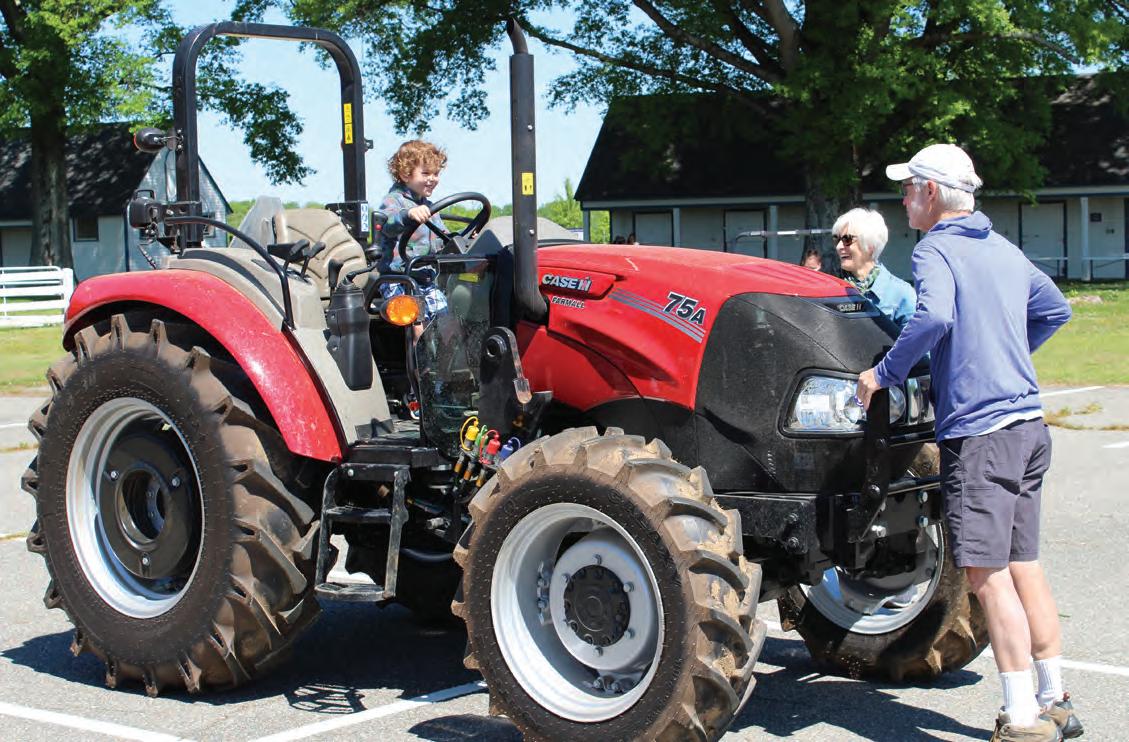
37 minute read
Save the Date
Visitors to the Virginia Farm Festival May 7 and 8 will get to explore farm vehicles, see farm animals and participate in other agriculture-related activities.
Ag Day, Ag Week, Agriculture Literacy Week observed in March
National Ag Day 2022 will be celebrated on March 22 during National Ag Week, March 20-25. The annual observances are organized by the Agriculture Council of America, a nonprofit organization dedicated to increasing the public’s awareness of agriculture’s role in modern society.
Virginia Agriculture in the Classroom will hold its annual Agriculture Literacy Week March 14-18.
Golf tournament will benefit AITC
The annual Virginia Foundation for Agriculture in the Classroom Charity Golf Tournament will be held May 2 at The Dominion Club in Glen Allen.
The event benefits AITC, and sponsorship opportunities and teams of four will be able to register for the tournament starting in February. The tournament will offer two shotgun starts with awards following each round of play. Food and refreshments will be available throughout the day.
Details are still being developed. For more information, contact Angela Buchanan at angela.buchanan@vafb.com or 804-687-4463, or visit AgInTheClass.org.
Virginia Farm Festival returns this May
The Virginia Farm Festival returns for a second year at The Meadow Event Park in Caroline County. The familyfriendly event will be held May 7 and 8 from 10 a.m. until 5 p.m.
This event focuses on spring planting season in Virginia, which culminates in the harvest season celebrated during the State Fair of Virginia, which will be held Sept. 23 through Oct. 2. During the farm festival, visitors can enjoy a day in the countryside, see farm animals, explore the garden, play in an AGtivity zone, savor some fair food favorites, shop at a farmers-artisan market and catch live entertainment.
Attendees also will have the chance to explore the interconnectedness of agriculture and lifestyle through food demonstrations and family fitness classes.
Tickets are $7 for all ages and will be available for purchase online at StateFairVa.org later this spring.
VFBMIC customers can help themselves with self-service options
BY ADAM CULLER
In today’s high-speed world of instant communication, insurance policyholders don’t always want to wait for their insurance agent to respond to a pressing matter.
Virginia Farm Bureau Mutual Insurance Co. understands its customers’ time is valuable, and the company is continually improving the self-service experience for policyholders.
“What we’ve really been trying to do over the past five or six years is to enhance our website, allowing our members to do more online,” said Ed Baumgartner, VFBMIC service center manager. “Once members create an account online or log in to an existing account, they actually can do quite a bit on their own.”
By logging into their online accounts, VFBMIC customers can access policy documents, retrieve ID cards for their policies, review their statements and pay bills. Customers also can request policy changes or file a claim electronically.
VFBMIC also implemented a quick-pay option in 2020 that allows customers to enter their policy number and ZIP code to make payments without logging in.
Virginia Farm Bureau customers— as well as prospective customers—also can take advantage of online resources without an account.
Customers can shop for auto quotes at vafb.com/insurance/get-quote, which will prompt an agent to reach out once a questionnaire is completed.
Customers also can browse a comprehensive library of insurance products at vafb.com/insurance to find auto, business, home and life insurance coverage that fits their needs. When new coverage options are made available, a brief description will appear on the webpage.
“As much as we love to communicate with our members directly, we know there are times when it may be difficult to reach us, and that there are members who would rather do things electronically,” Baumgartner added. “It’s all about convenience, and that’s why we’ve continued to roll out different technologies that allow our members to contact us and access their information in ways that suit them best.”
Existing customers also have the option to enroll in paperless services on their policies. Paperless provides email alerts when new policy documents are available, as well as round-the-clock access to policy documents and statements and the ability to pay bills online.
Policyholders can enroll in the paperless option by logging into their account on vafb.com. Customers who don’t have an online account may

Logging in to your Virginia Farm Bureau Mutual Insurance Co. account enables customers to access policies, review statements and pay bills online.
register at vafb.com/register.
Once logged in, eligible policies for paperless will be listed, and customers can choose which policies to enroll.
KATHY DIXON Some of Clore’s ladder-back chairs have been used in restaurants for 25 years.

BUILT TO LAST
Madison County furniture withstands the test of time
BY KATHY DIXON
What began with a table and chairs built for a church clerk in 1830 has transformed into a sixth-generation furniture business in Madison County.
Today, the descendants of Moses Clore are still handcrafting furniture in this historic Central Virginia locality. Instead of a church office, their early American hardwood furniture can be found in rooms on the Lawn at the University of Virginia, in dormitories at St. John’s College in Annapolis and New Mexico, and in homes across the United States and abroad.
When Moses Clore first designed the church furniture, he likely never imagined that his craft would become the world-class business it is today.
The company’s president, Troy Coppage, said the furniture has basically been made the same since his great-great-grandfather’s first pieces.
“We use all hardwoods, and we build things to last,” Coppage shared. The company sources American cherry, oak and walnut, and imports mahogany.
Pieces of tables, chairs, beds, dressers and cabinets are crafted using traditional machines—the newest of which is 30 years old, said plant manager Jeff Ford, who has been with the company for 32 years. The craftsmen still use a sander that was made by E.A. Clore, Coppage’s great-grandfather.
| collections |
Secretary desk, dining side chair and cow cutting board.
PHOTOS COURTESY OF CHORE FURNITURE
| handcrafted |
KATHY DIXON KATHY DIXON KATHY DIXON
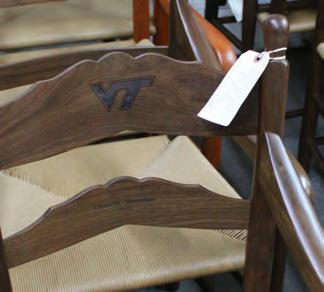

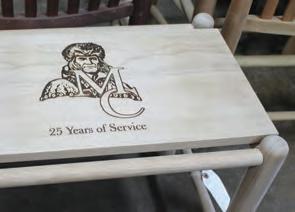

KATHY DIXON
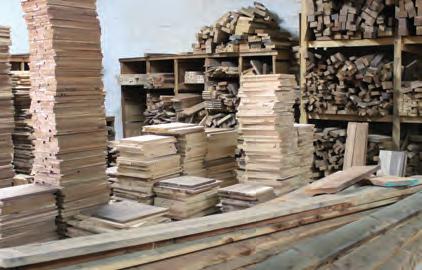
KATHY DIXON
Clockwise from top left: Anthony Brill stacks tenons that fit into mortises; customers often request special pieces; Roger Morris cuts back posts for a chair using a mortise machine made by the Clores; tenon and mortise construction is used in chairs and table legs; lumber is air dried behind the factory and used for Johnnie chairs like this one, which can be found in St. John's College dormitories in Annapolis and New Mexico.
KATHY DIXON
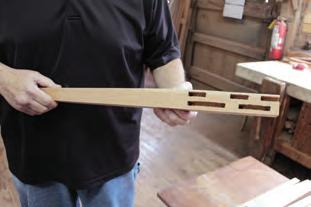


KATHY DIXON
Customers refuse to call it quits
Coppage credits a desire for American-made products for the company’s success. The factory almost shut down in 2016.
“Business was slow, and we announced plans to close,” Coppage said. “But our customers had different plans. Within two weeks, we went from a showroom full of inventory to an eight-month backlog of orders.”
Business has continued strong ever since.
Moses Clore handed the business down to his son who, in turn, handed it to his sons, E.A. and J.C. They operated the company until 1921. That’s when E.A. Clore opened the Madison factory with his four sons and named it E.A. Clore & Sons. “We just celebrated 100 years at this location,” Coppage remarked.
In 1946, the four sons bought the business from their dad, and the last one retired in 1984. Coppage’s dad and cousins then took over, and that’s when he started working part-time during college breaks. “I’ve been here ever since.” Coppage said the recently rebranded Clore Furniture is a bit of a niche business. “We’re bigger than small custom shops and smaller than mass furniture producers,” he explained.
Crafting remains the same
With 17 employees and buildings that are 100 years old, visiting the production side of the business is like taking a step back in time.
Covered with sawdust and wood pieces stacked and stored everywhere, it’s reminiscent of Geppetto’s workshop. The factory has a boiler room, and its wood heat warms the space. Pipes hanging from the ceiling are part of a ductwork systems that helps eliminate sawdust by moving it from the wood cutting tools into a centralized dust collector. “WE USE ALL HARDWOODS, AND WE BUILD THINGS TO LAST.”

— TROY COPPAGE
President,
Clore Furniture
Madison County
Furniture is made in stages, Ford said. Lumber is air-dried outside and kiln-dried inside, and then pieces are grain-matched and glued together.
Tenon and mortise construction—a centuries-old technique in which a shaped piece of wood is fitted into a mortise, or hole—is used for chair and table legs.
Drawers are constructed with dovetail corners, which are considered a hallmark of solid construction. A dovetail joint holds the sides of a drawer together in interlocking tails and pins so that the pieces fit tightly together.
While there are standard pieces made in the plant, furniture makers also create custom orders. Many customers purchase Clore furniture because their parents or grandparents owned pieces of it.
“It’s nice that some of our furniture has become family heirlooms,” noted Sara Utz, Coppage’s cousin and Clore’s office manager. “Passed-down pieces mean a lot.”
Coppage said the reason for their furniture’s popularity is simple: “People appreciate the quality and attention to detail.”
KATHY DIXON
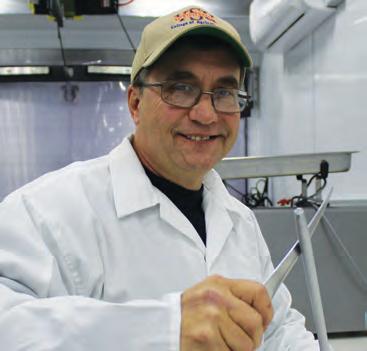
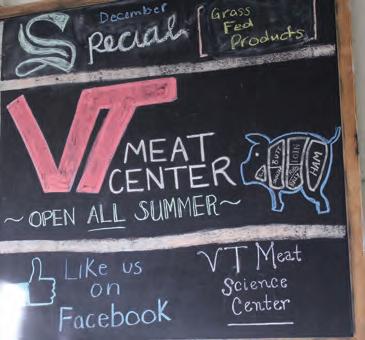
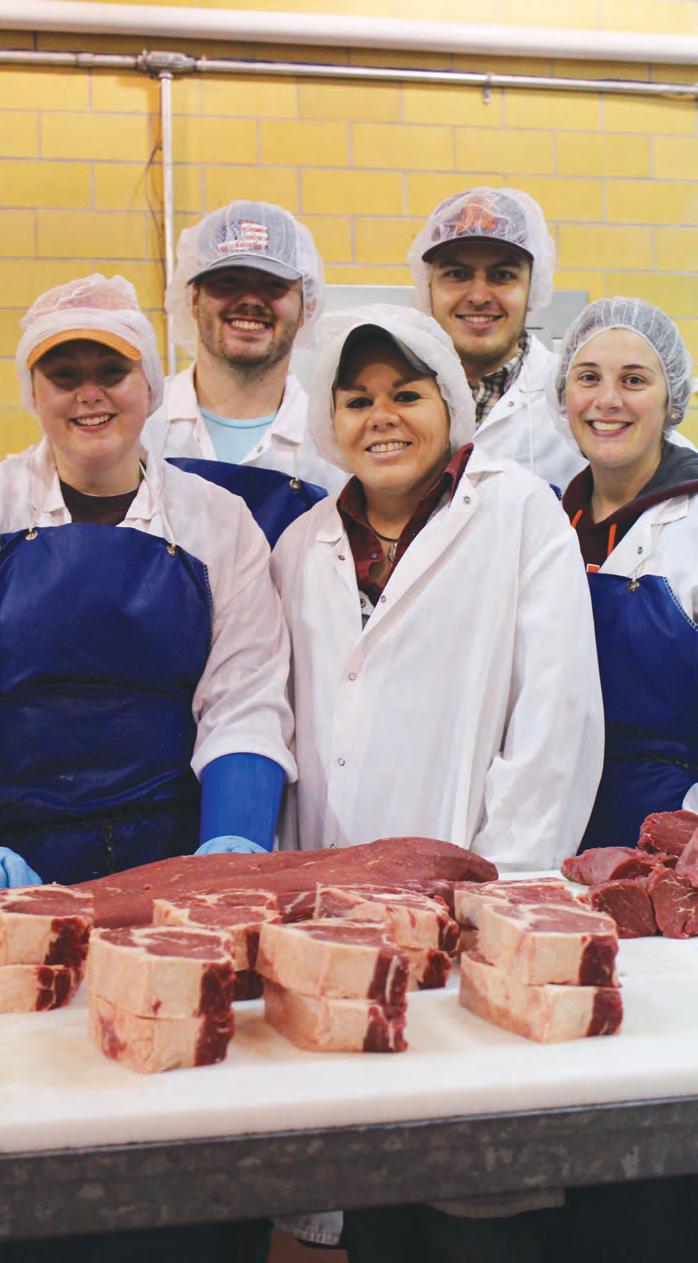

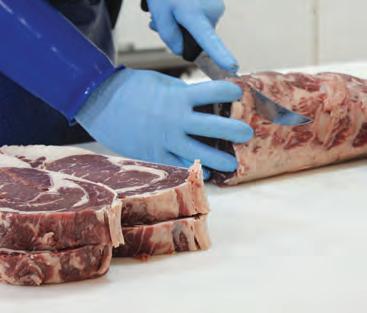
Glenn Clayton removes a tray from one of his Nelson County
beehives. Honey varieties reflect the flavor of the nectar source bees bring back to their hives. Beekeepers label the honey based on where most of the nectar came from, like clover, thistle or tulip poplar. Clockwise from top left: Life-long butcher Wallace Brousseau, a Virginia Cooperative Extension agent, raises and processes his own beef at home, and now educates beginning processors through Virginia State University’s Small Ruminants Mobile Processing Unit; Virginia Tech Meat Center manager Jordan Wicks, center, is pictured with senior students, from left, Amanda Bryan, Justin Taylor, Trayton McVey and Alex Kinsey; ribeyes are hand cut 1 inches thick; and Virginia Tech’s Meat Science Center retail store is open on Fridays.
High steaks skill
Beef cutting demands artful technique and attention to quality, safety
ARTICLE AND PHOTOS BY NICOLE ZEMA
Agood steak is the final chapter in a long story about the origins of our food.
It’s a narrative that begins with respect for the animal. Optimized feed and management strategies can translate into quality attributes like muscle marbling, color and tenderness, as researched by Jordan Wicks, Virginia Tech’s Meat Science Center manager and Ph.D. candidate.
Before a sirloin is ever sold in the center’s retail store, the cattle are raised and finished at Virginia Tech’s beef unit, and humanely harvested at the center’s state-inspected facility. Teams of Animal and Poultry Sciences students then quarter and age the carcass before carefully processing the meat into vacuum-sealed packs for local consumption.
“For me, this is the completion of the food cycle—the part where we’re feeding the community,” Wicks said. “Beef processing is a unique combination of both art and science. Learning the skill takes training and experience. It’s not hitting a button on a machine.”
She said students learn the science of producing the best-quality meat products possible, and the art to processing and packaging those products.
“But food safety is our No. 1 concern,” Wicks said. “Students understand the regulatory process and sanitation measures necessary for keeping the product safe and wholesome.”
Not your average classroom
A group of senior student workers were draped with hair nets, decked out with aprons and white coats, and equipped with knives and sheaths in December as they cut ribeye, sirloin and filets from rib and loin sections in Virginia Tech’s processing lab.
“It’s all done by hand here,” Wicks said. “One of the trickiest things is learning how to use the knife to cut at certain angles, using the right grip to avoid hand cramping, and measuring with their thumbs. We work with students intensively for the first couple weeks. By the end of the semester, they’re cutting steaks on their own.”
While some students have an agriculture background, they have not necessarily processed meat.
“It’s reassuring to see the entire process from start to finish, and I personally buy all my meat here,” said Justin Taylor, who plans a career in meat processing. “I needed the realworld, firsthand experience. At a bigger company, I’d be under more pressure. Here, you can actually take time to really learn the information.”
Proceeds from the retail store’s loyal customer base keep the facility operating, and working in the store educates students about marketing their beef, pork and lamb products.
“It’s real-world experience because these are real-life customers,” Wicks said. “If we get a complaint, the students learn how to handle that. And they answer customer questions. How was the animal raised? What is this cut? How do I cook it?”
Senior Alex Kinsey packaged, weighed and labeled steaks in the lab, keeping the customer in mind.
“I think it’s pretty to look at,” Kinsey said, holding a package of retail-ready ribeye. “You definitely want the right marbling ratio.”
Little is wasted. Some scraps go into ground meat, but parts with more connective tissue are used to create animal feed, fertilizer, oils, tires and cosmetics, Wicks said.
Pro reflects on the business
As students perfect their beef-cutting skills in university settings, butcher and Virginia Cooperative Extension agent Wallace Brousseau remembers processing beef as an 8-year-old with his dad in Connecticut.
Now with 35 years of experience as a butcher, Brousseau has touched every facet of the meat processing industry. He worked at a U.S. Department of
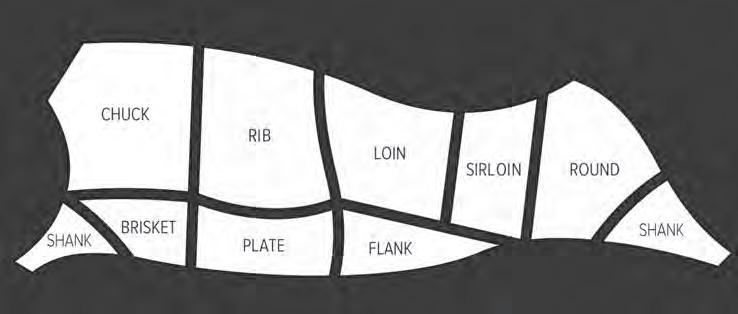
Agriculture-inspected slaughterhouse after high school, and entered the retail sector after that. Then Brousseau built his own processing facility in Maine, and eventually outgrew his small plant. He moved to Virginia and took a job as a meat inspector with the Virginia Department of Agriculture and Consumer Services.
“I will never regret taking that job because of the experience of regulatory compliance,” he said. “I know what happens on both sides. My whole life was geared toward education.”
Now he teaches meat processing through Virginia State University’s Small Ruminants Mobile Processing Unit.
Brousseau has seen the beef industry change, but said one fact remains the same—consumer choices are driven by the amount of money they have.
“I’ve found they don’t care about price per pound,” he continued. “They want to know, ‘How much will that package cost to feed me and my wife?’ They’ll get the highest quality they can with what money they have. Your job as a butcher is to steer them to that highest quality for their money. Plus offer tips on how to cook it.”
So how does an expert enjoy his steak?
“Ribeye,” Brousseau said. “On the grill with a little salt. I want my steak to taste like steak.”
Students Alex Kinsey, Trayton McVey and Justin Taylor hand-cut ribeye steaks 1 inches thick; different knives are used for different cuts of meat; McVey cuts picanha, also known as a Brazilian cut, often named top sirloin cap in the U.S.; and knives get sharpened daily.
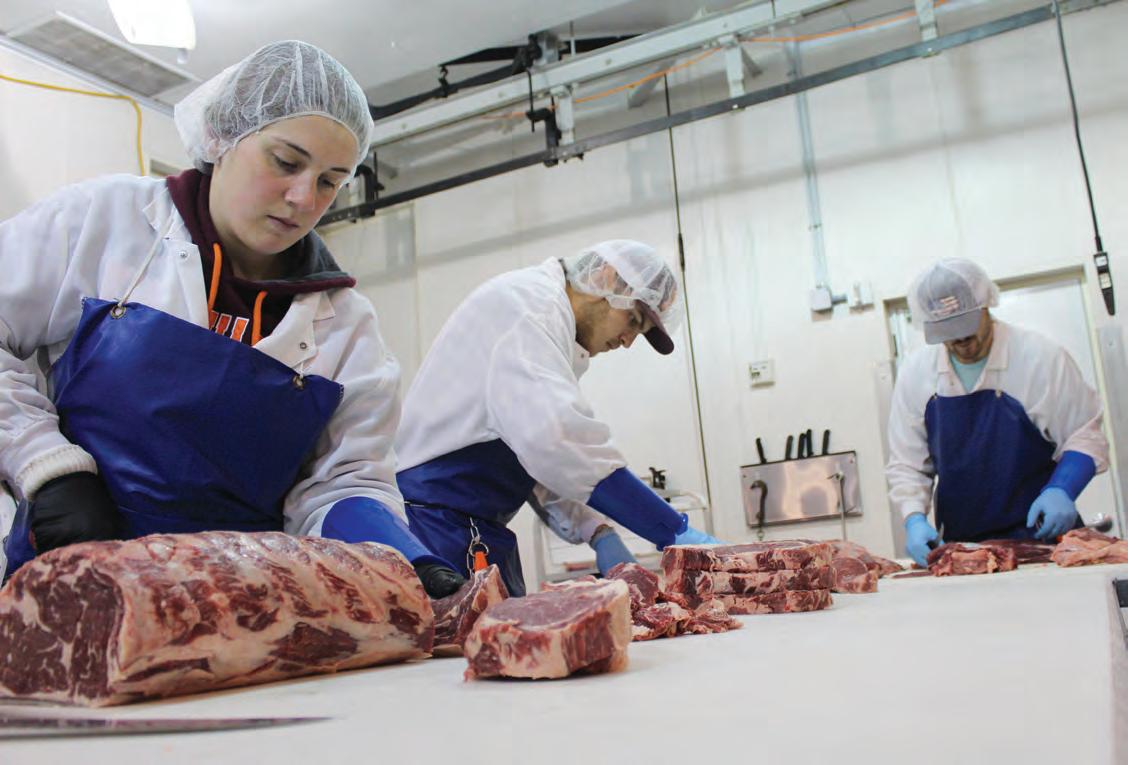
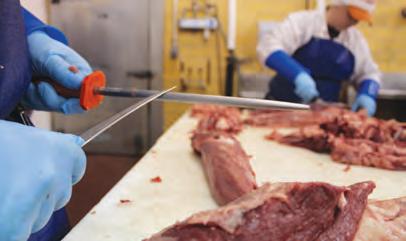

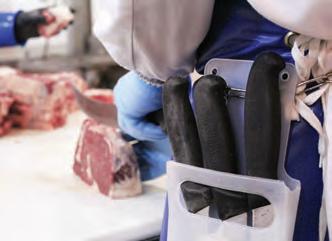
Protect your home from cold-weather disasters when leaving town
BY NICOLE ZEMA
Holiday cheer was put on ice for one Virginia family when they returned home from an extended vacation to find multi-floor water damage from a burst pipe in the attic.
Ann Hardee, a Virginia Farm Bureau Mutual Insurance Co. field claims manager, recalled a stream of water flowing from under a customer’s front door had turned to ice in the 2018 incident.
“In this case, they turned the thermostat down to 55 degrees while they went out of town for a three-week Christmas holiday, but we had a cold snap right after Christmas,” Hardee said. “It was cold as the dickens!”
As in many newer homes, the hot water tank was located in the attic. A pipe leading to the tank had frozen and burst in the cold snap, causing extensive water damage on the second and first floors, resulting in $100,000 in losses.
“We had to gut that house back to the stud walls,” Hardee said. “And everything had to be removed from the house. It was catastrophic to say the least.”
Even with the thermostat set in the 50s and sink cabinets left open, pipes in the attic can still freeze. Hot water tanks are often installed in attics to enhance the square footage of living spaces.
“We handle many claims because of losses caused by hot water heaters in the attic,” Hardee said. “And those claims are more frequent during a warm winter when temperatures suddenly drop down to the 20s.”
Inhabitants of newly constructed homes should be aware of this possibility, she said, and take precautions. Bump the thermostat into the 60s, and have a neighbor, friend or family member periodically check on the house. The same goes for secondary homes that are inhabited sporadically.
“Major losses can happen overnight,” Hardee added. “Have somebody come by and check things out.”
VFBMIC’s property experts also recommend letting faucets drip during extreme cold and insulate pipes that are most susceptible to freezing, such as those running along exterior walls. Inspect and replace weather stripping, if necessary, and caulk around windows and doors to ensure your home’s interior stays cozy when temperatures plummet.
If a snowstorm hits, use a snow rake to promptly remove accumulated snow to prevent roof damage. In addition, take steps to prevent ice dams—thick ridges of ice that build up along a roof edge and prevent melting snow from draining.
Finally, perform routine roof maintenance throughout the year, inspecting and repairing any damage to fortify your home against winterweather disasters and extend the life of your roof.

Winter weather calls for extra homeowner precautions, like insulating pipes.
The name "Thunder Ridge" is a marriage of emus' Australian nickname, thunder chickens, and the farm's location on a slight ridge in Warrenton. Emus earned the nickname because the females make a deep rumbling noise that sounds like thunder.
EMUS:

A unique bird in a niche market
ARTICLE AND PHOTOS BY ALICE KEMP
Emus are unusual animals. With their long, thin necks, beady eyes and dinosaur-like scaly legs, they’re curious but will quickly scamper away if you get too close.
To Anne Geller, owner of Thunder Ridge Emu Products, their quirky characteristics add to their charm.
“They’re very neat animals,” Geller remarked. “They have so much to offer.”
Geller considers emus her “bread and butter,” having raised them since 1993. She discovered them when she and her late husband, John, were becoming more health conscious. Lean and low in cholesterol, emu meat fit in their low-fat diet.
“But it turned out the oil is the real prize,” she commented.
Used in cosmetics and skin care, emu oil is renowned for its moisturizing properties and contains omega fatty acids 3, 6 and 9. Geller has a line of 15 products she sells online and at her shop in Manassas—oil, lotions, lip balm, foot cream
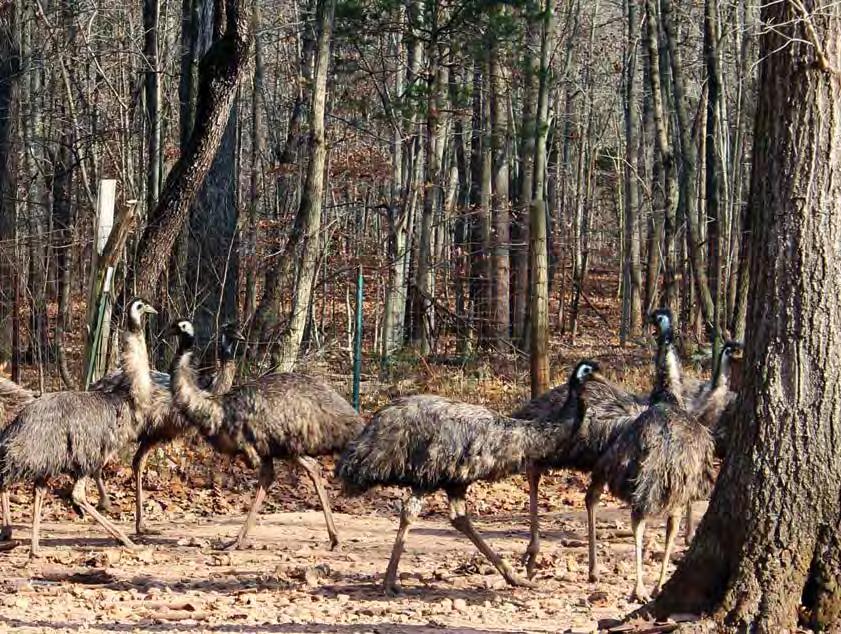
and more. She also makes products under a private label for a large health and wellness company.
“A lot of cosmetic companies are now using it in their antiaging skin care products,” Geller said. “Once you’re hooked on it, there’s no going back. It’s wonderful.”
In a paddock located up a slight hill, a mob of emus roam from one end to the other, almost blending in with the wooded landscape.
“The ground is just so bare,” said Andy Deskins, gesturing to the well-traveled ground. “They never stop, they walk continuously.”
Deskins manages Geller’s 30-acre farm in Warrenton. At one point, the property housed nearly 2,000 emus and was the largest operation on the East Coast, but Geller downsized after her husband died a few years ago. Now home to about 20 emus, she contracts with other U.S. emu producers to source supplemental oil.
Deskins said there’s one rule when it comes to raising animals that can run 35 miles per hour.
“Never let them get out,” he warned. “You talk about a headache. You can’t catch ‘em. It’s not like a cow or nothin’, they just want to get away from you.”
Native to Australia, emus are very different from their aggressive ostrich cousins. Relatively docile and lowmaintenance, they prefer to leave people alone unless threatened.
But raising emus has some drawbacks.
Feed and infrastructure are expensive
“The feed is so pricey,” Deskins said. “When we had all of the emus, it’d be like $10,000 a month in feed.”
Emu feed is a specially-formulated, protein-packed pellet— ranging between 18% to 22% protein, and high in fiber. Deskins supplements it with corn, as it’s “less than half the
Male emus have a blue tinge to their skin, and after females lay the eggs, the males roost and raise the hatchlings.
Products derived from emus include lotions, lip balms and shaving oil. Emus are raised for oil and meat, which is lower in cholesterol than turkey and higher in iron.
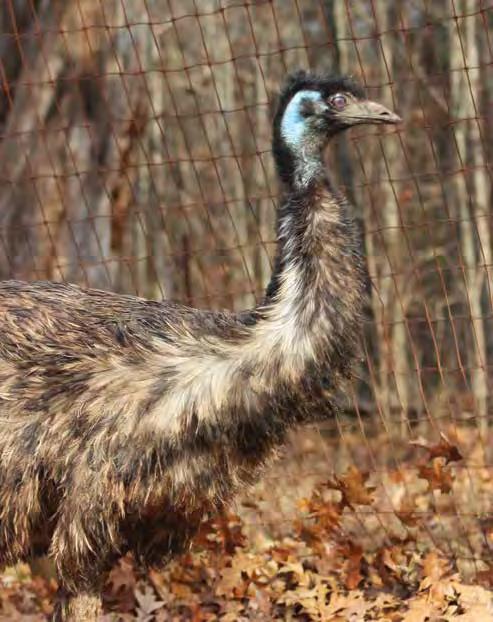
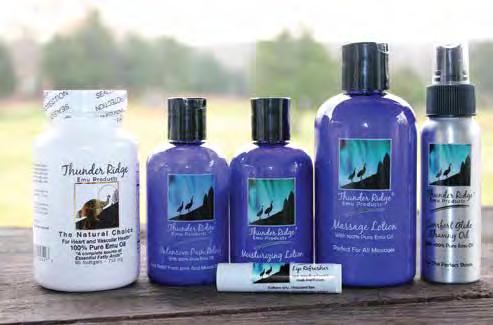


Anne Geller uses her personal vehicle to advertise her products, which are known for their moisturizing and medicinal properties.

Emu eggs are among the largest, with an average length of 3-5 inches.


Geller owns Thunder Ridge Emu Products, and Andy Deskins manages her mob of emus in Fauquier County.
cost of emu feed.”
There also are many upfront costs to raising emus, said Jay Winslow of the American Emu Association.
“It’s infrastructure-heavy farming,” Winslow explained. “You’ve got to have smaller pens and rotation so you can manage the birds—you have to build a lot of paddocks. Combined with the expensive feed, that’s why a lot of folks shy away from it.”
Emu meat is a niche market
In the 1990s, a fervor erupted over emu as the “next mostpopular” meat. Farmers invested heavily in the birds expecting large payouts, but it turned out to be a short-lived fad.
“We developed the industry before we developed the market,” Geller explained. “We were selling the birds about as fast as they were laying eggs, but we were selling them to other emu people and people getting into the emu business. Wrong, wrong, wrong thing to do.”
With an oversupply of emus and no big market for products, the bottom fell out and farmers began exiting the emu business. Now the emu farms around are “mostly hobby farms.
“People who have five to 10 birds, that kind of thing,” Winslow said.
According to the 2017 U.S. Department of Agriculture Census of Agriculture, there are roughly 1,500 farms and about 11,500 emus in the U.S.
Winslow explained that while most farmers raise emus for the oil, there is a growing niche market for emu as another lean, healthy meat option. Most sales are direct-to-consumer or at local farmers markets, and those who rigorously market their product do well.
“People are starting to learn,” Winslow said. “There’s money to be made in it—in the oil and the meat. We want more people to raise the birds, but at the same time, we don’t want to have another ‘90s thing.”
Geller attributes Thunder Ridge’s success to her Northern Virginia location near Washington, D.C., along with aggressive marketing—attending natural products trade shows and traveling to places like Dubai and Singapore to sell her oil.
“I’ve got backorders,” she said. “We have one customer that has a standing order of 2,500 4-ounce bottles of oil.”
More than 1,500 agricultural sites recognized as Virginia Century Farms

In the story of Virginia’s rural heritage, every historical farm is a setting for life’s dramas. Those farms encompass births and deaths, new ventures, failures, economic gain and loss, and changes—to the land, the industry and the family. A lot can happen in 100-plus years.
A state program was established by the General Assembly in 1997 to recognize those properties in the official record, with 1,508 farms officially designated as
Virginia Century Farms. Southampton County leads the state with 97.
Jennifer Perkins, coordinator of the Virginia Department of Agriculture and Consumer Services Office of Farmland
Preservation, said there are more farms that qualify.
“Agriculture is such an essential part of who we are as
Virginians,” Perkins said. “If you’ve made it 100 years or more, it’s a huge accomplishment that ties into our history.”
Where there is one Virginia Century Farm, you’ll often notice more nearby.
“Information about the program travels by word of mouth, the occasional newspaper story or signs on the road,” Perkins said.
The application is free and the process is straightforward. Per Virginia State Code, the farm must be owned 100 years or more by a descendant of the original owner. A descendant must currently live on or farm the property. And the operation must gross $2,500 or more in sales from the farm.
“We don’t require title or financial records,” Perkins said. “But we do ask that your application is notarized, so we know you’ve answered truthfully, to the best of your knowledge.”
Perkins processes applications monthly. Once they are approved, her office sends applicants a certificate signed by the governor and VDACS commissioner, with a Virginia Century Farm sign. Extra or replacement signs cost $25 each.
SPRING GARDEN

FARM
Louisa County
BY NICOLE ZEMA
Spring Garden Farm was the site of a corn, grain and produce operation and where Richard Anderson “Dickie” Trice III was born in its stately historic house in August 1938.
Perhaps named for freshwater springs on its original 180 acres in Louisa County, Spring Garden Farm has been inhabited by six generations of the same family since 1807.
Trice had cancer and died at home in April 2020.
“His circle of life began and ended at Spring Garden Farm,” said Trice’s wife of almost 55 years, Charlotte. “We put his bed next to the windows where he could see the barn, fields and lake. I’m so glad we kept him here, especially when the nursing homes closed to visitors. He loved this farm.”
Charlotte didn’t leave his side. And even in his absence, she’s staying in the Spring Garden Farm house, which the couple renovated years ago. The home is a historical show piece enhanced with all the modern comforts.
The farm was honored with a Virginia Century Farm designation about 10 years ago.
“I know our son will live here with his family, which will be the seventh generation,” Charlotte said. “But as far as the eighth generation, I don’t know. One day I was collecting branches and limbs with my grandson, loading them into a pickup truck. I said, ‘Someday this will go to you. Would you like this place?’ He said, ‘No, Granny, this is too much work!’”
Picturesque Spring Garden Farm in Louisa County includes fields, barns and a view of Lake Anna's Elk Creek.
NICOLE ZEMA LAKE ANNA BREEZE

TRICE FAMILY NICOLE ZEMA

Clockwise from top left, Charlotte Trice continued operating Spring Garden Farm after her husband died in 2020; three generations of Trices help with the farm; and the modernized farmhouse beside a photo of that house in the 1970s.
NICOLE ZEMA
Spring Garden became a waterfront farm in 1972 with Dominion Energy’s creation of Lake Anna—a decision that Richard Trice II and other nearby farmers publicly opposed. Spring Garden Farm was a 200-head dairy at the time, and 40 acres of it was lost in the new lake, splitting its grazing land and creating a 13-mile detour. That parcel of land eventually was sold to a developer.
“The older generations didn’t like the lake so much, but we got a boat and enjoyed it,” Charlotte recalled. “I’ve always loved the water. I often asked Dickie, ‘Why don’t we buy a place at Nag’s Head?’ We lucked out. All of a sudden the water came to us.”
Trice stopped farming about five years before his
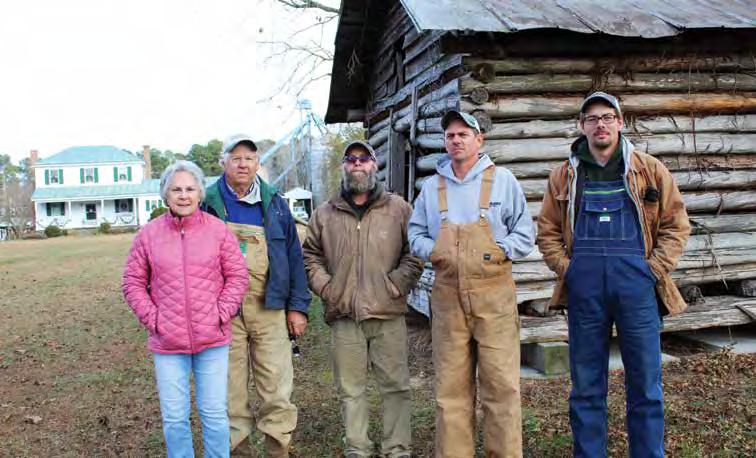
Three generations operate Greenfields Farm in Isle of Wight County. From left, Lynn and Johnny Butler farm with their sons, Gregory and Thomas, and their grandson, Samuel.
health declined. A tenant farmer now plants corn and soybeans on the land overlooking Lake Anna’s glittering Elk Creek.
“I told him he can’t ever plant corn between me and the lake,” Charlotte said. “He’ll tease me and say, ‘I’ve got some short corn I can plant.’ And I say, ‘No, it wouldn’t be short enough!’”
GREENFIELDS
FARM
Isle of Wight County
BY KATHY DIXON
The more things change, the more they stay the same.
After 121 years, members of the Butler family are still farming on Greenfields Farm in Isle of Wight County. John Thomas “Johnny” Butler Jr.’s greatgrandfather, Stephen Thomas Butler, started the 333-acre farm in 1900, using a grubbing hoe to clear the land.
Today, Johnny and his sons, Thomas and Gregory, and his grandson, Samuel, use modern machinery to plant, grow and harvest corn, cotton, hay, peanuts, soybeans and wheat, and raise over 200 head of cattle. On this Virginia Century Farm, the work may not look the same as it did at the turn of the century, but the dedication to the land and the passion for farming does.
“Either we love what we’re doing or we haven’t learned to do anything else,” quipped Thomas Butler, the fourth generation working on the farm. “But I haven’t found anywhere else I’d rather be.”
Johnny Butler and his wife, Lynn, are the current farm owners. They live on-site in the house that was built by Henry Pruden of Pruden hams. After Pruden and his wife died, the property was sold, and after a year, it went up for auction.
Stephen Thomas bought it, and in 1900 expanded it from a 1½-to a two-story house. Then Johnny’s grandfather, Chilion Shepherd Butler, resided there in the early 1930s and added two additional back rooms. Johnny’s father, John Thomas, lived in the house with his parents and Stephen Thomas from the 1930s until the year he married Johnny’s mother, Eva.
Johnny and Lynn have lived in the house since 1970 and have modernized and renovated it some. However, much of it remains the same—including original floors in the front part of the house.
Johnny noted that the farm was different at the turn of the century because the family couldn’t run to a grocery store for food. There were orchards on the land, and they raised hogs for their own consumption. Much of the farm was forestland, which has since been cleared for row crops.
A cypress barn cut from trees near the town’s courthouse is still on-site, as is a tin barn and smokehouse. Several barns that were originally located on the front lawn have been removed.
The Butler men share the bulk of responsibility for planting and harvesting the crops and raising the cattle, and Lynn is the bookkeeper, errand runner and farm


Old-fashioned tools used by the first generation of Butlers are stored in a ham curing shed that's occasionally still in use on the property. This family photo shows Johhny Butler as a child with his father, grandfather and great-grandfather. When farms are recognized as Century Farms they get a certificate and a letter signed by the current governor.
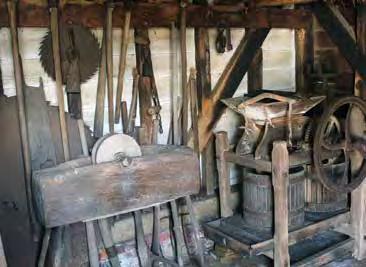
chef. “What she does is very important to this operation,” Johnny noted.
She also managed the campground that they operated on the property until 2012.
The family read about the Century Farm program when it began in 1997. When they were eligible in 2000, Lynn applied for the designation. A sign is now proudly displayed at the entrance to the farm.
Thomas Butler said the designation can be a conversation piece and often leads to people requesting more information about the farm. “They are usually in shock that our family has been here this long.”
To learn more about Virginia Century Farms, see the list of farms, or access an application, visit the website at bit.ly/3rR6zJS
Or contact Jennifer Perkins, coordinator of VDACS Office of Farmland Preservation at 804-786-1906 or jennifer.perkins@vdacs. virginia.gov.
Is your forestland eligible for Virginia’s Century Forest Program?
Established in 2016 by the Virginia Department of Forestry, the Virginia Century Forest Program honors more than 50 families whose property has been in the same family for 100 years or more and includes at least 20 contiguous acres of managed forest. So far, a total of 16,879 acres are recognized statewide.
The application form and process provide landowners an opportunity to demonstrate how their family has exhibited a long-term commitment to enhancing the environment and protecting Virginians’ quality of life. If your family and property may be eligible, contact 434-2209021 or centuryforests@ dof.virginia.gov to apply.
Tales of the Dairy Godmother named AITC Book of the Year
Virginia Agriculture in the Classroom’s annual Agriculture Literacy Week will take place March 14-18.
Virginia AITC has selected Tales of the Dairy Godmother: Chuck’s Ice Cream Wish by Viola Butler as its 2022 Book of the Year. Vibrantly illustrated, the book follows Chuck as he is magically transported to a dairy farm to get the inside scoop on his favorite creamy treat—from milking cows to the grocery-store shelf.
Agriculture Literacy Week is the largest educational event of the year for AITC, with thousands of volunteers reading to children across the commonwealth. Now in its 11th year, the program helps teach youth about

Virginia students will learn how dairy products get from the cow to the store in this book that will be read during Agriculture Literacy Week, March 14-18.
the importance of agriculture, farming and the sources of their food.
“Volunteer agriculture advocates are excited to have an opportunity to share a book and personal examples about farm life with children from across the state. Creating a connection from farms to food is vital to understanding the importance of agriculture to our daily lives,” explained Tammy Maxey, AITC programs director.
Copies of Tales of the Dairy Godmother: Chuck’s Ice Cream Wish are available for purchase at $12 each from AITC. A book order form is located on the AITC website, AgInTheClass.org.
Volunteers are encouraged to read Tales of the Dairy Godmother: Chuck’s Ice Cream Wish to children in prekindergarten through the third grade. AITC also will share highlights on its social media platforms throughout Agriculture Literacy Week.
For details or to order books, visit AgInTheClass.org.
OPEN

NEW DOORS

Are you searching for new opportunities on your farm? Explore your options with a reliable lending partner like Farm Credit.
farmcredit.com
Prep your garden for spring planting
BY ALICE KEMP
Spring is just around the corner, and now is a great time to plan what to grow and how to prepare your garden for the planting season.
Mark Viette, horticulturist and host of In the Garden on Virginia Farm Bureau’s Real Virginia television program, said his first word of advice is “Always wear gloves.” This will help gardeners avoid getting splinters or cuts when working in the dirt.
He also advised never working the soil when it’s too wet, as this will cause it to compact, preventing it from absorbing air and water.
Viette suggested home gardeners use the following checklist to spruce things up for spring: ❏ Do a late-winter cleanup by removing dead foliage and fallen leaves from the garden. Throw away anything that’s had insect or disease problems. Other debris can be added to the compost pile for nutrients. ❏ Cut back ornamental grasses. They’re great to leave for much of the winter to shelter wildlife but should be pruned to about 3 inches from the ground to encourage new growth. For an easy way to cut ornamental grasses, visit bit.ly/33csUHo.

Birdhouses should be cleaned out before spring nesting begins. Wearing gloves while pruning trees will protect you from injuries.
❏ Prune dead or diseased portions of shrubs and evergreens like boxwood or cypress. Remember not to prune healthy growth until it gets warmer. ❏ Feed your garden with organic fertilizers. This ideally should be done after the garden cleanup and before mulching. ❏ For vegetable gardens, get rid of plant debris such as old tomato vines.
If you have fruit trees, throw away old fruit and leaves, as they often have fungi spores that can re-infect the trees. ❏ If planning to grow tomatoes in a vegetable garden, now is a good time to add dolomitic limestone and gypsum to the surface of the vegetable garden to help prevent blossom end rot issues. ❏ If using compost in your garden, add 1-3 inches of compost, and work it into
the ground using a garden fork or tiller. ❏ Spray your fruit trees with an all-season horticultural oil spray to help mitigate pest and disease issues.
Be sure to follow the label instructions. ❏ Depending on your planting zone, February,
March and April are a good time to divide and transplant plants like hostas, daylilies, liriope,
Solomon’s seal and groundcovers like sedum. ❏ Clean out bird houses before spring nesting season begins. Keep your feathered friends comfortable by emptying old debris once a year, checking for mold and mildew and cleaning with a gentle diluted dish soap and warm water solution if needed.
Damage to underground lines can be covered by adding an underground service line endorsement to your homeowners insurance policy.
What lies beneath
Underground service line insurance picks up coverage where your homeowners policy leaves off
BY ADAM CULLER
Homeowners know that when a water line bursts, a gas line leaks or lightning fries their home’s electrical system, it can be a nightmare to repair.
While a homeowners insurance policy with proper endorsements may provide some coverage for service line failures directly under a residence, the coverage does not extend to lines throughout the rest of the property. To avoid financial peril brought on by a service line failure, it’s advisable to consider adding underground service line coverage to your homeowners policy.
“Weather-related damage, or that caused by fire, lightning or even an earthquake, is covered under a properly endorsed homeowners policy,” explained Lisa Whitus, personal and commercial lines underwriting manager for Virginia Farm Bureau Mutual Insurance Co.
“What isn’t covered is damage caused by normal wear and tear, rust and corrosion, collapse from a vehicle running over a line, or someone hitting and damaging a line when digging, which is where this endorsement picks up.”
Whitus explained that when utility lines serving a policyholder’s property are damaged on the premises of that property, the landowner is financially responsible for the repair. Exclusions to this rule occur when a line runs under a residence or under a body of water, or if the lines are not connected and ready for use.
However, when you add the underground service line coverage endorsement to your homeowners policy, the entirety of your property is protected from service line failures. Service lines covered by the endorsement include compressed air, drainage, electrical, gas, sewer, telecommunications and water.
Covered losses include those caused by external force from digging, freezing, mechanical breakdown, rust and corrosion, tree and root invasion, vermin, wear and tear and weight stress.
Additionally, the endorsement will pay for the direct damage caused by a service line failure, excavation costs and the replacement of outdoor property, including driveways, walkways and greenery. It also provides coverage for additional living costs or loss of rent caused by a failure, as well as pays for temporary repairs or to expedite permanent repairs.
“The reality is that every homeowner has direct exposure to losses that can be caused by a service line failure,” Whitus said. “If you have water, electricity, internet or a phone line running to your home, certain perils are not covered without an underground service line coverage endorsement. Considering everything this endorsement covers, I have to say it provides a great coverage limit for an excellent price.”
To learn more about the affordibility of underground service line coverage, contact your Virginia Farm Bureau insurance agent.

Ask the experts: Reasons to call your insurance agents
BY ADAM CULLER
Whether it’s your personal or professional life, times are constantly changing. Every now and then, some of those changes may require you to take a step back and consider your insurance needs.
From purchasing a new home, building a business or watching your family grow, your insurable interests can shift at a moment’s notice. When those changes occur, it’s an excellent idea to get in touch with your Virginia Farm Bureau insurance agent.
Notifying your agent of any changes—big or small—will help ensure your family, business and personal property is protected into the future. Even if there are no changes, meeting for a regular policy review can help identify coverage gaps that could result in substantial financial losses. There are many good reasons to contact your insurance agent, and here are a few examples from the experts at Virginia Farm Bureau Mutual Insurance Co.
1“Are you considering driving for a ride-share company or a thirdparty food delivery service? You should contact your agent to make sure you have adequate liability limits on your auto policy for these situations.” – Anne Baskette, director of claims administration
2“If you’ve made any renovations or built additions on your home or any other structures on your property, it’s important to notify your agent. In most cases, the corresponding changes in value will necessitate updated coverage.” – Scott DeNoon, senior farm product and underwriting manager 3 “With property values increasing throughout Virginia, it’s imperative you contact your agent to ensure you have sufficient coverage on your home or property. During the conversation, your agent also can share valuable insurance endorsements that will fit your needs.” – Laurie Gannon, vice president of claims
4“It’s a great idea to call your agent to ensure your spouse and children are covered on your insurance policies, and to explore the idea of acquiring life insurance for the entire family.” – Gerald Gardner, director of sales 5 “Did you recently have a new baby? Are you caring for aging parents who may be living with you now? Reaching out to your local Farm Bureau agent will make sure you have protection in place for everyone in your household.”
– Barry Light, senior product development manager
6“If your business has developed a website that accepts payments, online orders or any other transactions that require obtaining the purchaser’s personal payment information, call your agent to make sure you have the right cyber liability coverage to meet the needs of your business.”
– Lisa Whitus, personal and commercial lines underwriting manager 7 “If you are buying a new car, contact your agent and ask about adding new vehicle replacement or loan-lease coverage to your policy to protect the full value of your vehicle.” – Ed Baumgartner, underwriting service center manager




